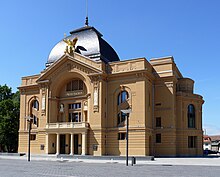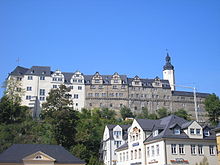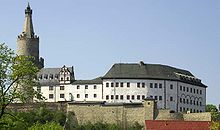Reussische Fürstenstrasse
The Reussische Fürstenstraße is a holiday route that runs 113 kilometers from Bad Köstritz to Bad Lobenstein through Thuringia .
The route planned by the Thuringia Tourism Association in 1992 leads through the Thuringian Vogtland, which was ruled by the Prince of Reuss for around 800 years .
course
The Reussische Fürstenstrasse begins at the gates of the city of Gera in Bad Köstritz . From the former palace and palace park Bad Köstritz only the columnar structure of the White Lady of the Lower Park, Count Heinrich XLIII, is preserved. Reuss zu Köstritz , art patron and architecture lover, had it built in 1785.
Gera was one of the two ancestral seats of the Russian royal family. High above the city, the Osterstein Castle, which was founded in the 12th century, testified to the rule and prosperity of the imperial princes. On April 6, 1945, Osterstein Castle was hit by Allied bombers and burned down. Although still largely preserved, the palace complex was blown up on December 9, 1962. As part of the " National Reconstruction Work ", today's Terrassencafè Osterstein was built on and from the ruins of the former castle below the preserved castle tower. While only remnants of the grounds can be seen on the Schlossberg today , the grounds of the Hofgut, located below the White Elster , as well as the orangery , the kitchen garden and the theater (today: Theater & Philharmonie Thuringia ) have been completely preserved.
Wünschendorf was in an outstanding position as the Reussian estate. Art treasures such as the 1000-year-old St. Vitus Church, which dominates the landscape, still bear witness to this importance. It is one of the oldest churches in Germany and also contains what is probably the oldest preserved colored church glazing. The Mildenfurth Palace and Monastery and the historic wooden bridge in Wünschendorf also date from the Reussian era.
The Osterburg has stood over the East Thuringian city of Weida for over 800 years . This castle goes back to the bailiffs of Weida as the ancestors of the Reussians, but was later owned by the Wettins . It was used as a youth hostel until 1985 , after which it was renovated and since then the castle has been largely unused, but can be visited.
Like Gera, the impressive Lower Castle in Greiz was the residence of the Reuss Princely House for centuries. It was built in the 16th century by Heinrich the Elder. Today there are two museums in the castle.
To the south of Schleiz is Burgk Castle , the former Reussen summer castle , fortified as a rather rare Randhaus castle and equipped with an extensive park. It is now a museum.
The Reussische Fürstenstrasse ends in the spa town of Bad Lobenstein . It was the residence of the princes of Reuss-Lobenstein. The castle and its parks have been preserved. From Lobenstein Castle, however, there are only ruins left today.
Sights along the way
Castles
- Schleiz Castle
- Burgk Castle
- Upper Greiz Castle
- Lower Greiz Castle
- Greiz Summer Palace
- Doelau Castle
- Ronneburg Castle
- Osterstein Castle in Gera
- Hofgut Osterstein in Gera
- Mildenfurth Castle and Monastery in Wünschendorf
- Orangery Gera
- Tinz Castle in Gera
- Köstritz Castle in Bad Köstritz
- Ebersdorf Castle
- New castle in Bad Lobenstein
- Malting Bad Lobenstein
- Wernburg castle ruins
- Eisenberg Castle
- Crossen Castle
- Blankenhain Castle
Castles
- Reichenfels castle ruins
- Osterburg Weida
- Saalburg ruins in Saalburg
- Lobenstein Castle in Bad Lobenstein
- Elsterberg Castle
- Posterstein Castle
- Triptis Castle
- Pöllnitz Castle in Harth-Pöllnitz
- Berga Castle
Churches and monasteries
- Fortified church St. Nikolaus in Pöllwitz
- Parish Church of St. Veit ( Veitskirche ) in Wünschendorf
- Mildenfurth Monastery in Wünschendorf
- Ruins of the Cronschwitz monastery
- Widenkirche in Weida
- City Church St. Marien in Weida (former Franciscan monastery)
- Peterskirche in Weida
- Marienkirche in Gera- Untermhaus
- Mountain church in Schleiz
- Monastery ruins "Zum heiligen Kreuz" Saalburg monastery
- Friesau fortified church
- Fortified church in Schüptitz
Parks
- Landscape park in Greiz
- New landscape Ronneburg
- Kitchen garden in Gera
- Hofwiesenpark in Gera (formerly the Federal Garden Show 2007 )
- Dahlia garden in Gera
- Botanical garden in Gera
- Landscape park in Tannenfeld (to Posterstein Castle)
- Landscape park in Bad Köstritz
- Lobenstein Castle Park
- Ebersdorf Landscape Park
More Attractions
- Burkersdorf Manor
- Covered wooden bridge in Döhlen
- Historic wooden bridge in Wünschendorf
- Parish in Döhlen
- Winkelmann's house in Triebes
- Village green Nitschareuth
- Oschützal viaduct in Weida
- Zscherlich Bridge Zeulenroda
- Town hall in Zeulenroda
literature
- Siegfried Mues: The Reussische Fürstenstrasse ; 1995; ISBN 3-931635-00-7
- Reussische Fürstenstrasse eV: Reussische Fürstenstrasse - Discover the beauties of East Thuringia in the footsteps of the Reussian princes ; Self-published by Reussische Fürstenstrasse eV; Greiz 2001
- Erhard Lemm, Angelika and Frank Schenke, Siegfried Mues: The Reussische Fürstenstrasse ; Lemm advertising; Gera 2005; ISBN 3-931635-33-3
Movies
- ARD, MDR: Thuringia - picture book Germany - from the upper Saale to Reussische Fürstenstrasse ; UAP Video GmbH; Leipzig 2005; DVD, Europa-Pal, 4: 3
swell
- District of Greiz: The Reussische Fürstenstrasse
- Landesbibliothek Coburg: Cultural and historical holiday routes (PDF file; 213 kB)






